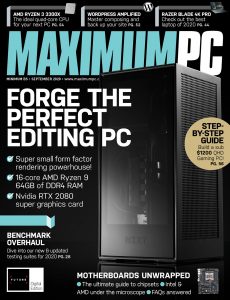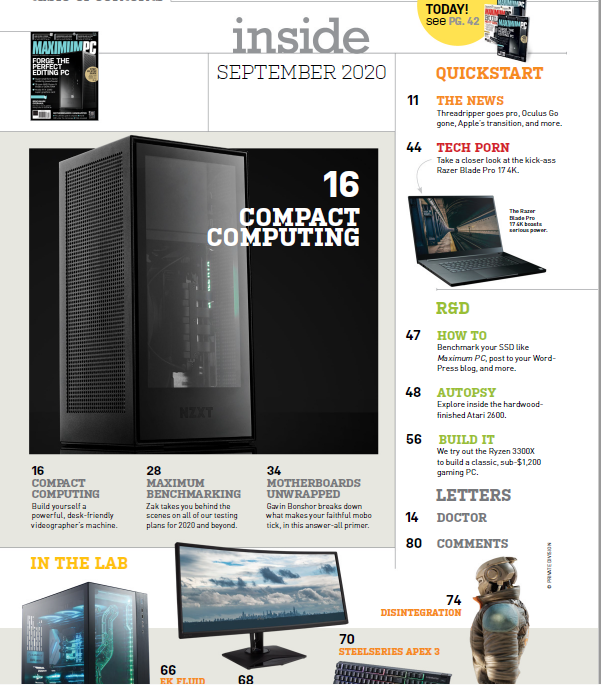
Maximum PC – September 2020
English | 87 pages | pdf | 54.61 MB
Even in the last five years in our own heady domain, computational performance has quadrupled in the mainstream marketplace, and in the land of HEDT it’s more than six times higher than when we first started, and that’s just on core count alone. Moore’s Law may not be to thank for that— intuitive complex chip design is—but nonetheless the amount of power we can achieve in our mid towers today is incredible. And that got us thinking.
Just what can you do in the smallest of form factors. In particular, we’re talking about ITX. It’s long been a love of mine, for gaming or otherwise: The perfect balance between size and performance. In fact my very first rig that got me into Maximum PC to begin with was a conversion of an ATX tower into the BitFenix Prodigy ITX chassis with a Core i5-2500K at its heart. It was only when I managed to overclock that processor all the way up to 5.4GHz on a single 120mm radiator that I began to understand just what you could do with the form factor. It was small, compact, easy to transport, and yet insanely powerful, and a match for some of my friends’ biggest machines.

Fast forward to 2020, and that i5- 2500K’s heyday is long over, so I set Christian to the task of building a super-small form factor PC, designed specifically with video-editing in mind. ITX comes with limitations: Two slots for memory, very few storage options, and a single add-in card, so just how well would it do, and what’s the most we could put into it? You might be surprised how much we managed to get out of that beautifully crafted NZXT H1 chassis.
In this Maximum PC Magazine issue we’ve also recruited Gavin Bonshor of An and tech fame to break down exactly what makes motherboards tick on PG 34. On top of that, we’ve decided to overhaul our benchmarking suite and testing methodologies, and introduce a digital benchmark database that you can check out on PG 28.
But it’s not all just videography and charts. In our build-it this issue, on PG 56, we’ve decided to take on AMD’s Ryzen 3 3300X to see how well it performs at 1080p and 1440p gaming. This quad-core, eight-thread processor is in high demand, and with good reason: Coming in at just $127, it’s the equivalent of a modern Core i7 from 2017 and makes mince meat out of any AAA title you throw its way.
On top of all of that, we’ve got a selection of fantastic how-to tutorials, including how to test your SSD, a continuation of our WordPress tutorial series, detailing how to create posts and pages, and a bevy of reviews, columns, and more.
Stay safe out there, and I look forward to seeing you next time. – Zak Storey is Maximum PC’s editor
Download from:
One Response to “Maximum PC – September 2020”
Warning: call_user_func_array() expects parameter 1 to be a valid callback, function 'embed_bbcode ' not found or invalid function name in /home/magdownload/public_html/wp-includes/class-wp-hook.php on line 310